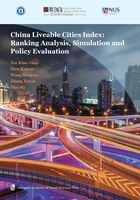
1.3 Outline of the Book
The CLCI presented in this book ranks 100 cities in China, including Hong Kong, Macau, and cities in Taiwan, based on a total of 120 indicators. Among the 120 indicators, 90 indicators are derived from hard data and 30 indicators are derived from survey data. The hard data used are data for 2016 that were gathered from established publicly available sources. The survey data were collected through random phone surveys from July to October in 2019 across all 100 Chinese cities covered in the study. More than 300 successful responses were gathered in each city, which amounts to a total of 31,502 responses for the entire project.
As discussed in the previous edition of 100 China Liveability Cities Index book, we agree that summing up all aspects of a city by a single number is an exercise fraught with many deficiencies. However, the simplicity and the clarity afforded by the use of a single number to depict the liveability conditions of a city serves as a clear signal to the policymakers especially where action is required to tackle the problem of liveability in that city. Furthermore, the examination of the five environments under the CLCI framework enables policymakers to make cross-city comparisons and hence identify the aspects of liveability that most urgently require enhancement. At the same time, the What-if simulation reveals the potential of each city to make improvements in its liveability conditions.
Table 1.1 Literature Review on Liveability Studies and Indices

<b><i>Source:</i></b>Asia Competitiveness Instituteand Shanghai Academy of Social Sciences.
The rest of the book is organised as follows: Chapter 2 introduces the research methodology including a detailed description of the CLCI framework, the criteria to select 100 cities covered in the study and the algorithm to calculate the ranking. Chapter 3 presents the empirical findings on the rankings for overall liveability and each of the five environments as well as the what-if simulation results.There are two sections in Chapter 4. Section one further studies domestic security and infrastructure development of the Chinese cities, while section two compares the survey results between the year 2015 and 2019. Chapter 5 is a case study that examines liveability in terms of infrastructure and transportation, followed by concluding remarks on the making of a comprehensively liveable city from the perspective of ordinary urban dwellers.